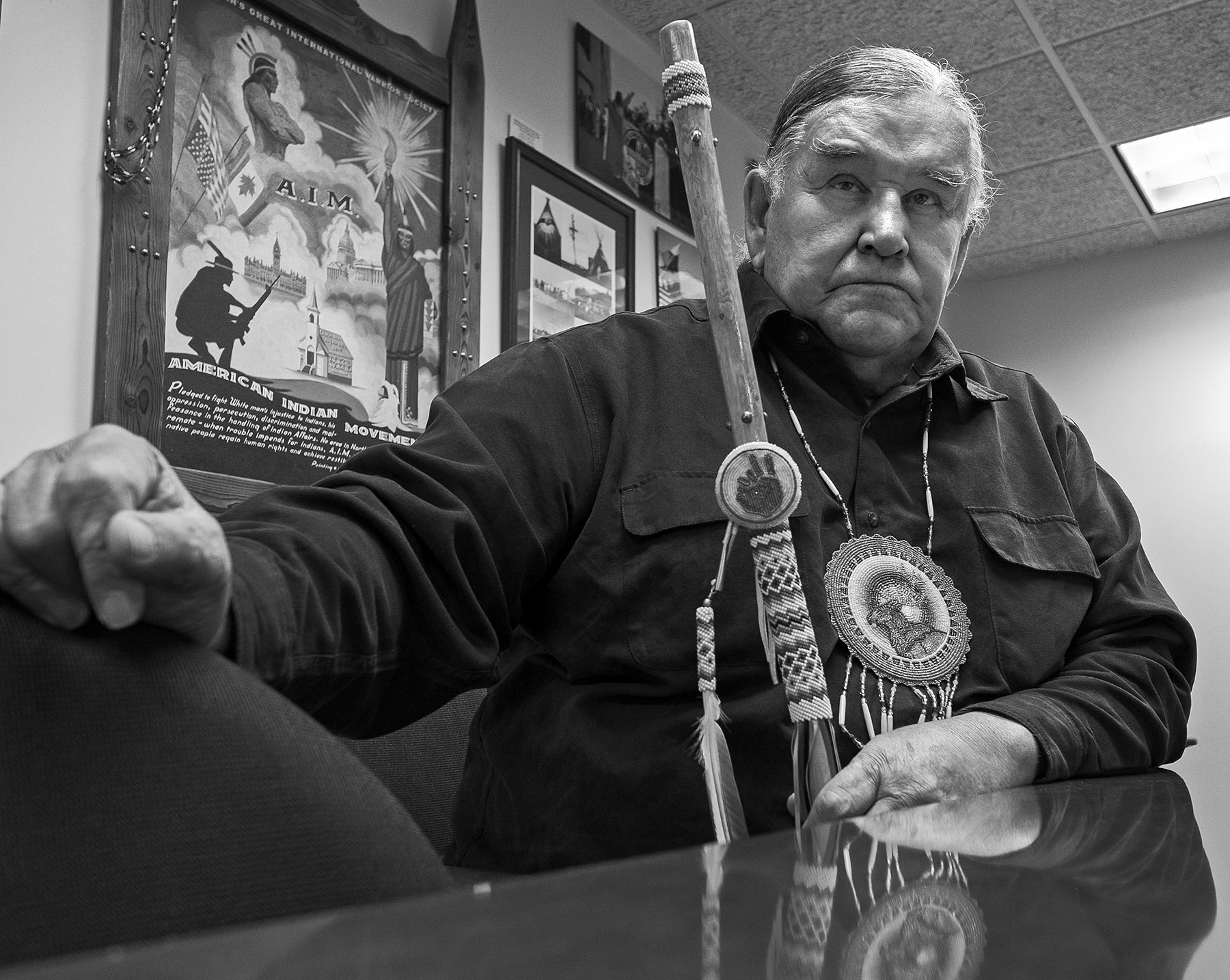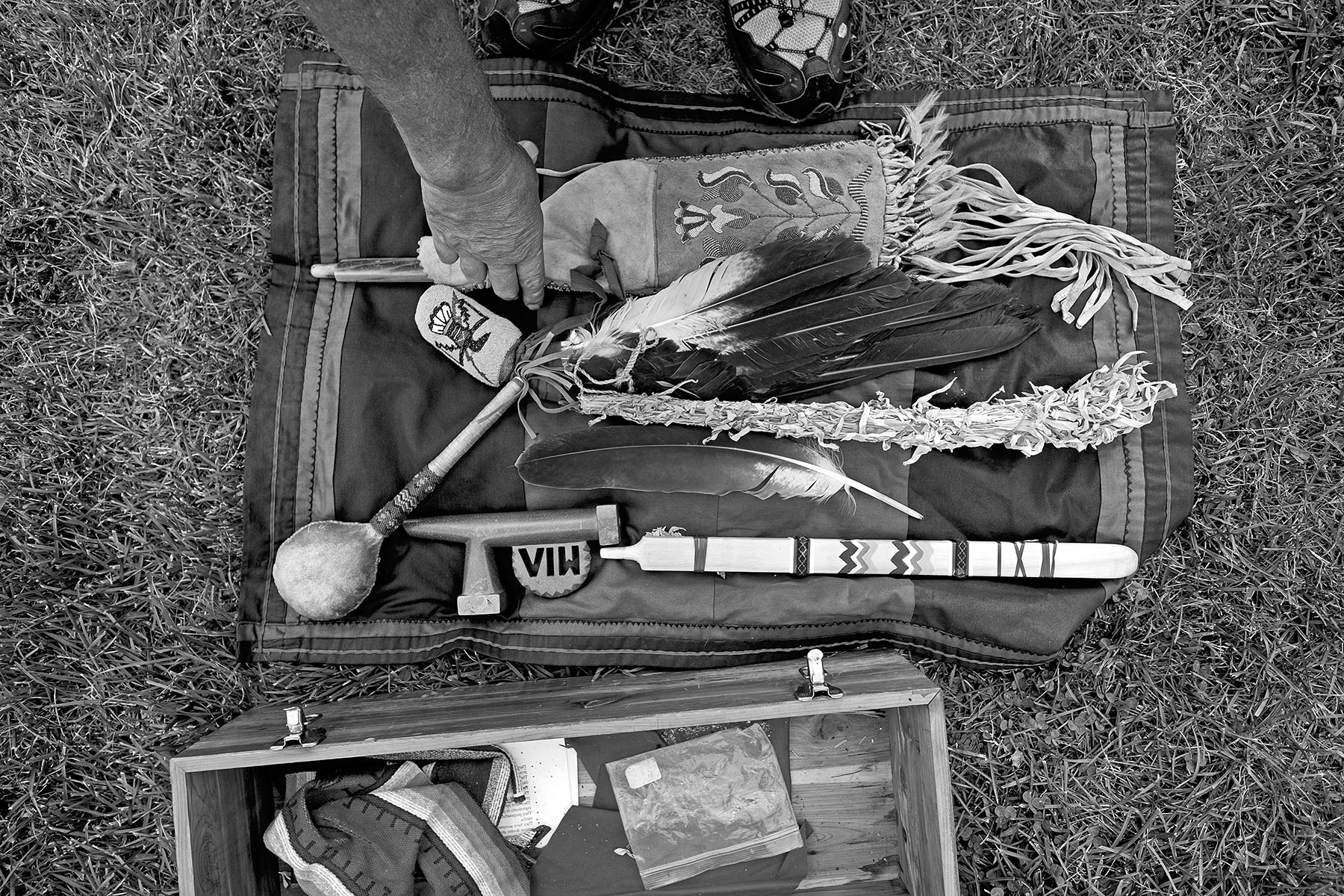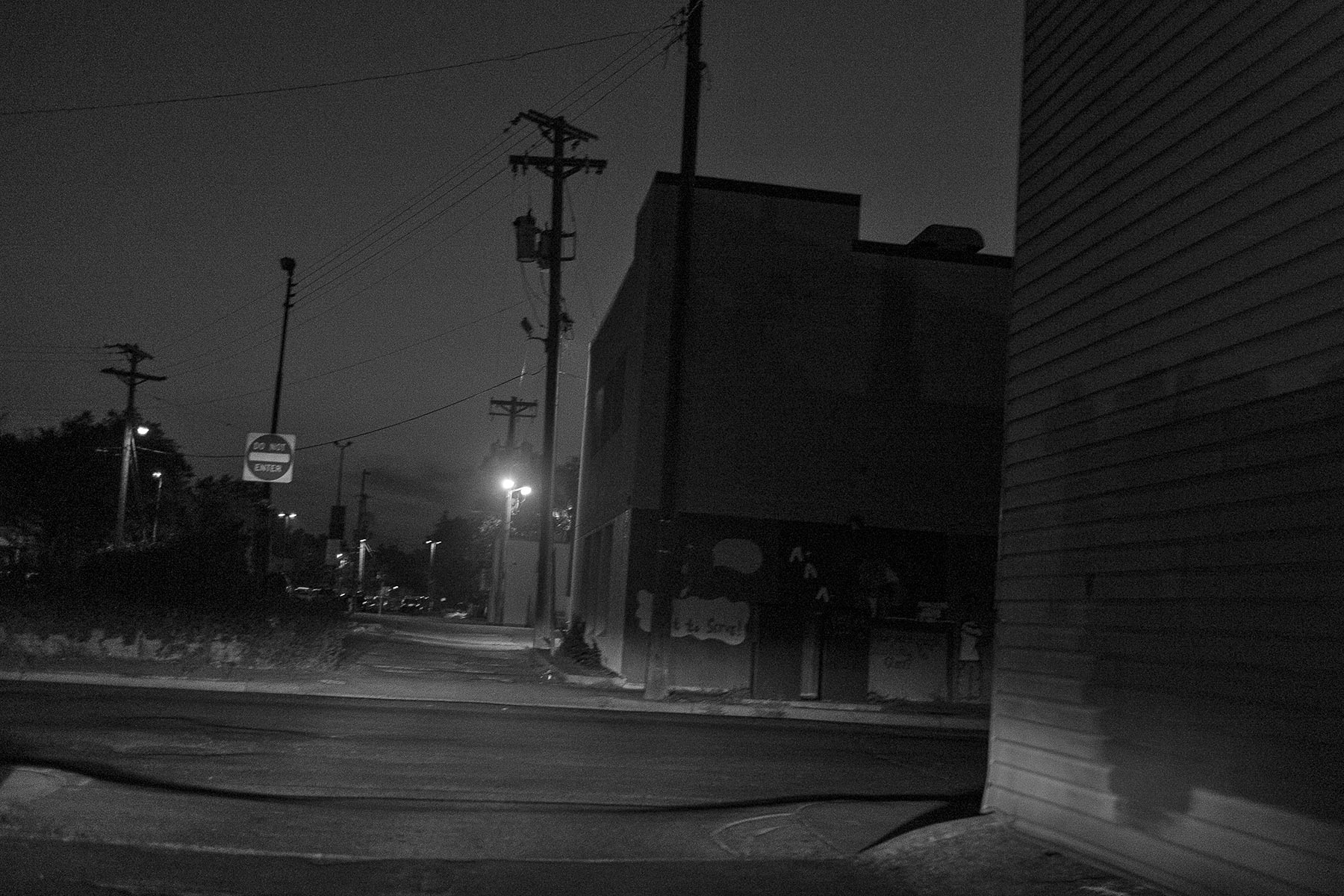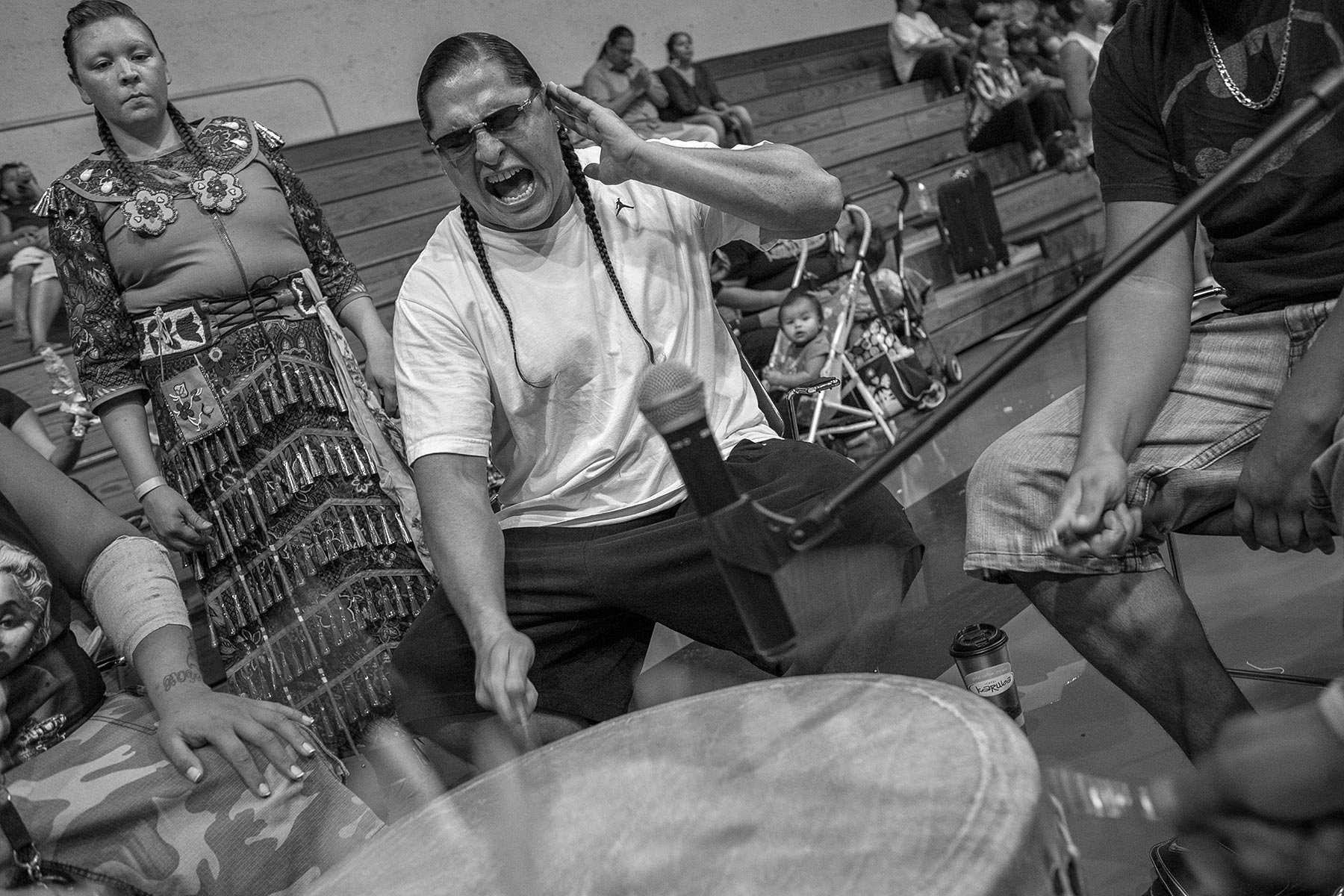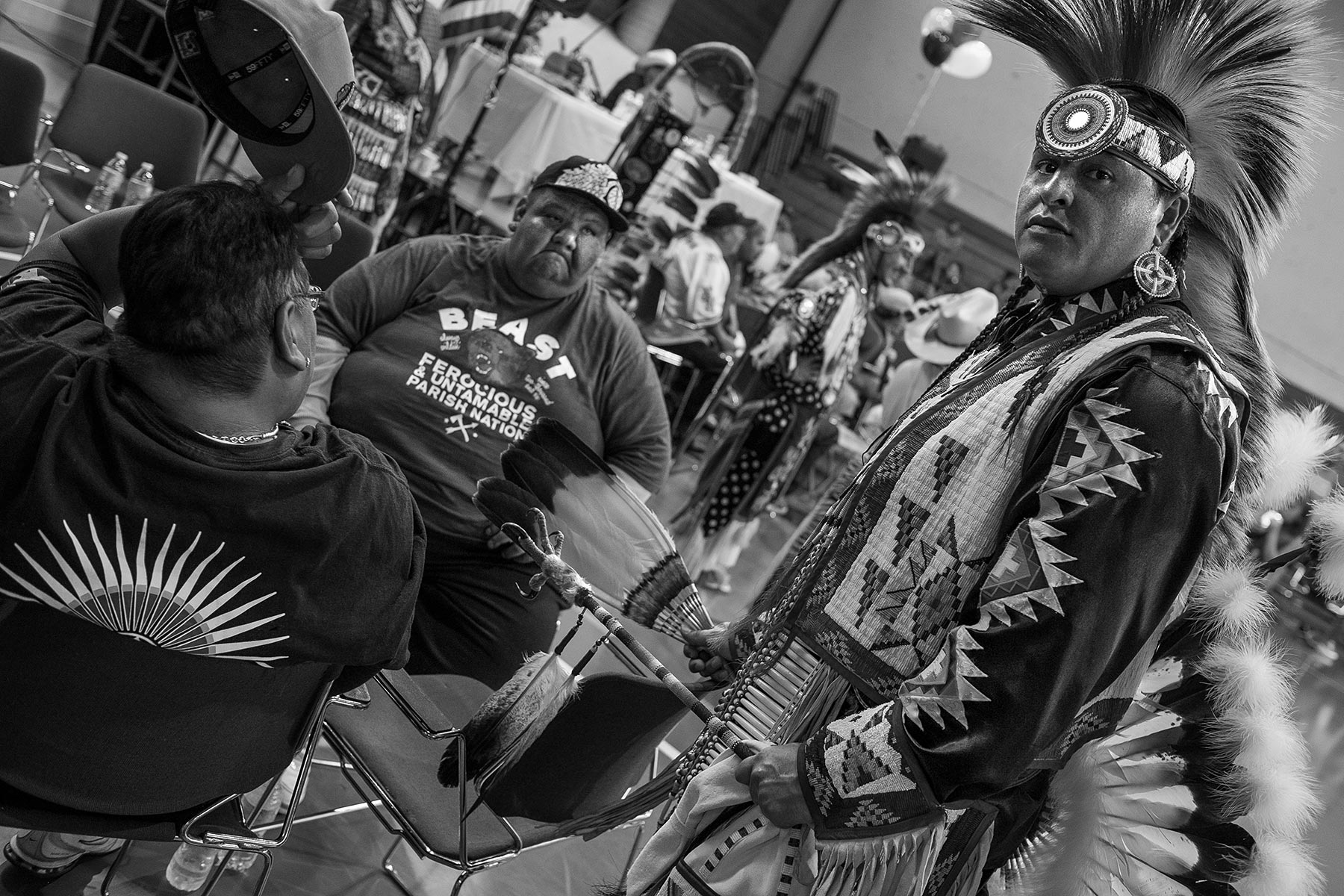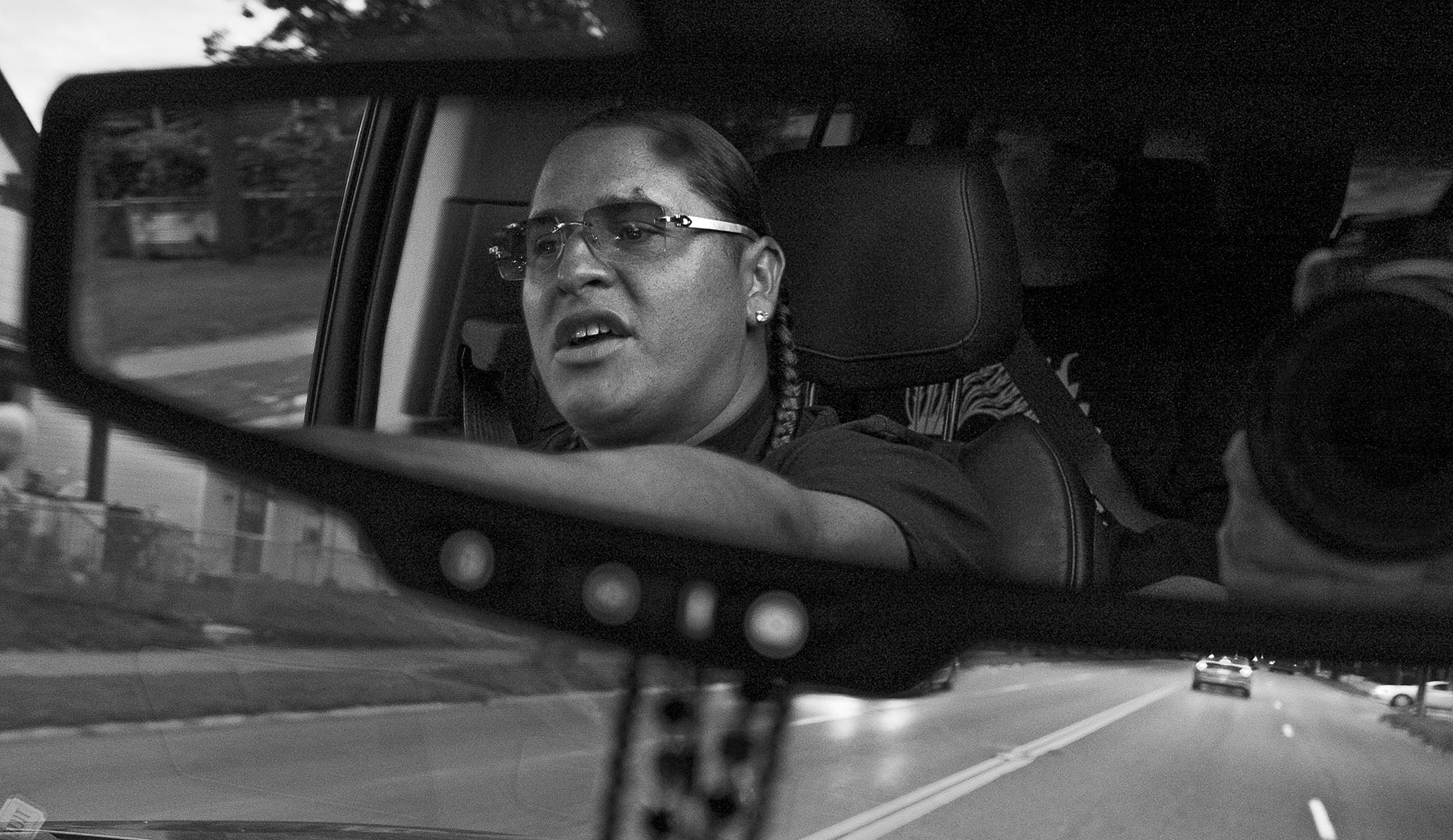
Aiming for a higher ground
The American Indian Movement hopes to rise again, but a new leader needs to shake gang ties
About this project
This is is the third story in a five-part series on Native American gangs.
By Tristan Ahtone for Al Jazeera America
Photos by Tomo for Al Jazeera America
Edited by Mark Rykoff, Katherine Lanpher
Reuben Crow Feather in his Escalade, above.
Published on Wednesday, January 21, 2015
MINNEAPOLIS — From the plush leather interior of a black Cadillac Escalade, Reuben Crow Feather looked out to the streets and pointed to a corner lit only by the red, yellow and green glow of a changing stoplight overhead and a nearby fast-food sign.
“When I was on the block here in Minneapolis, I would keep a .44 Desert Eagle with one in the chamber with the safety on,” he said. “I wouldn’t have to slide it. All I’d have to do is flip the switch and rock. It was a cannon.”
Crow Feather, a Dakota tribal member, is a big guy. Barrel chested with veiny arms, two long braids and tinted glasses, he regularly displays a toothy grin when talking and has a habit of raising his voice to a threatening decibel when engaged in a monologue.
Convicted of drug trafficking in 2008 and identified by law enforcement as a leader of the Minneapolis-based gang Native Mob — a charge he denies — he is currently on parole and says he makes most of his money dancing and singing professionally at powwows across the nation. He is also preparing for a new step in his life: political activism.
At 38, Crow Feather is poised to become a leader in the American Indian Movement (AIM), an organization that was born on the streets of Minneapolis in the 1960s to protect civil rights and later become an internationally infamous militant Indian organization that took on the federal government.
“We’re the equivalent of the Black Panthers,” said Crow Feather. “But we’re culturally based.”
His ascent to a leadership role in the organization raises questions about how a new generation of AIM leaders will keep the nearly 50-year-old organization alive and relevant for a generation of Native Americans that now fight their battles in court, not through protest or 1960s-style actions. It also raises questions about whether AIM can transcend its role as one of the most polarizing forces in Indian Country politics and whether its new leaders can get beyond their own sordid pasts.
“I’m not a Native Mob chief,” said Crow Feather. “I’m a chief. That’s what I am, and the people will say it — I’m a leader.”
While he was in prison, the last thing Clyde Bellecourt ever thought he would do was lead the revolutionary Indian organization AIM into direct battle with the United States.
Born on the White Earth Reservation in northern Minnesota and raised in Minneapolis, he went down a road of alcohol and crime as a young man. By his mid-20s, he found himself in Stillwater Prison, a minimum security penitentiary in the St. Croix Valley outside St. Paul.
One day last fall, Bellecourt and his protege Reuben Crow Feather drove to Stillwater. The two were dressed in ribbon shirts, garments specific to Indian Country and tantamount to a shirt and tie. The two had driven out from Minneapolis to discuss the future of the movement and to see the prison in which AIM began.
“I was in this block,” he said as he walked the edge of Stillwater prison’s razor wire. “I was in here 25 months.”
“Only prison I’ve been in in Minnesota is Sandstone,” said Crow Feather as he walked alongside Bellecourt, eyeing the prison’s 100-year-old walls.
During his time in Stillwater, Bellecourt came into contact with other Native people and began to learn about his culture and traditions, from language to songs and ceremonies. He advocated successfully for the prison to allow Native prisoners to engage in those practices, including religious ceremonies like sweat lodge.
“I started having dreams of being an eagle flying over South Dakota and seeing these beautiful sun dances,” said Bellecourt. “Even the horses were dancing, and that’s what I wanted for my life. That’s what I wanted to do when I got out.”
“How old were you?” asked Crow Feather.
“When I came in here, I was around 22 or 23.”
“Just a baby,” said Crow Feather.
When Bellecourt was released, he took home what he learned in prison and began organizing with other tribal members living in Minneapolis. The issues affecting his generation included housing, education, employment and police brutality against the city’s Indian population.
“[AIM] came out of a really, really poor relationship that existed between the Minneapolis cops and the Indian community here,” said Eric Buffalohead, chair of the American Indian studies department at Augsburg College.
Bellecourt and other tribal members began locally organized safety patrols that monitored police actions in Minneapolis’ Native neighborhoods. “They started the AIM patrols, and those went on throughout the ’70s, just looking to protect Native American people,” said Buffalohead.
Within a few years, they had revived the image of longhaired, rifle-toting Indians fighting for their rights and their land and became synonymous with the burgeoning red power movement across the country.
“They got people paying attention to Indian politics for the first time for a very long time in very important ways,” said Mary Stuckey, a professor of communications at Georgia State University. “They provided a positive, stalwart, important kind of option in which assimilation wasn’t the only choice, urbanization was not the only option and that there was such a thing as a culture that was worthy of pride and defense.”
They painted Plymouth Rock red for Thanksgiving, took over Mount Rushmore and in 1972 occupied the Bureau of Indian Affairs building in Washington, D.C. A year later they grabbed headlines again in Wounded Knee, South Dakota.
On Feb. 27, 1973, about 200 AIM members drove into the Pine Ridge Reservation’s town of Wounded Knee — where in 1890 the 7th Cavalry massacred more than 300 Native men, women and children — and took control of the town for 71 days, in hopes of removing Tribal Chairman Dick Wilson, whom AIM and many reservation residents perceived as dictatorial, corrupt and pro-assimilation.
By the end of their siege in 1973, two AIM supporters were killed during shootouts with authorities and black civil rights activist Ray Robinson disappeared. By 1975, two FBI agents were shot and killed, and prominent AIM member Anna Mae Aquash was murdered.
Local residents were left to deal with the aftermath, and in the years after Wounded Knee and AIM’s departure, the reservation faced bloodshed and terror.
“Similar to what happened to the Black Panther Party in California that led to the development of gangs in Los Angeles is that you have a lot of youth that are incredibly active, who are alienated,” said Casey Kelly, an associate professor of communications at Butler University who has studied how AIM used media. “The generation before them are in jail or dead, and they’re sort of left with systemic poverty and time on their hands.”
In 1985, Clyde Bellecourt was caught selling LSD to an undercover cop, and in the 1990s, he and his brother Vernon Bellecourt were expelled from the movement for drug sales, collaboration with the federal government against indigenous people and, as a tribunal put it, “high treason against the membership of the American Indian Movement and American Indian people in general” by members of the Autonomous Chapters of the American Indian Movement, based in Colorado and headed by former movement leaders like Russell Means. Five years later, Means publicly accused Clyde Bellecourt and Vernon Bellecourt of ordering the 1975 murder of Anna Mae Aquash after misidentifying her as an undercover FBI agent.
Today two primary factions of AIM exist: the Autonomous Chapters of the American Indian Movement and the American Indian Movement Grand Governing Council, based in Minneapolis and headed by Clyde Bellecourt.
Reuben Crow Feather has been pegged as a member and leader of the Native Mob by state and federal authorities. He’s been accused of threatening witnesses to testify falsely. He’s been convicted of drug trafficking. He’s broken bread with the leaders of Native Mob, partied with them, been photographed with them and undertaken criminal activities with them. But he says he was never a member.
“I deny it to the end,” said Crow Feather. “I was definitely involved with the gang — I’m not going to deny that — but am I one of them? No.”
The distinction is so fine that the only one who seems to care is Crow Feather.
“I command a respect that’s bigger than the gang,” he said. “I’m more dangerous than a gang member. I’m a dangerous person because I have a heart. I have love. That’s what makes me dangerous to people who would do something against my people.”
Crow Feather’s word for this is “tokala,” which in Lakota roughly means “a traditional warrior who would give his life for his people.” He is working hard to rehab his image from one as a gang member to that of a revolutionary warrior.
Both his parents were AIM members, and he says that, thanks to their activism, he grew up learning the Dakota cultural practices.
At the age of 14, he says, he began sun dancing and taking part in traditional ceremonies. By 18, he had begun committing burglaries and strong-arm robberies, selling marijuana and fighting, and his mother subsequently threw him out of their home.
He eventually spent nearly six years in prison and hopes that today, through his participation with AIM, he can start creating city programs like a halfway house, a place where American Indians who are sincere in their sobriety can participate in spiritual practices, job placement and counseling — even though multiple facilities like that already exist in the Twin Cities and elsewhere in Minnesota.
He’s working to earn a degree in addiction studies and says he hopes things can start coming together for a new American Indian Movement, tackling what he sees as the pressing issues of his generation: substance abuse and cultural loss.
For AIM to survive another 50 years, leaders like Crow Feather will have to find ways to make the organization relevant to a new generation not familiar with ’60s-style revolution and find ways to make amends for the group’s darker years.
“When social movements in general from the ’60s moved off the streets and into the courts, then the particular kind of expertise that AIM brought to bear became less important,” said Georgia State’s Stuckey. “There didn’t need to be the protests because there were court cases. There were gains, but most of those gains came through the courts — and let’s face it, that’s not sexy.”
Crow Feather steered his Escalade through the South Side of Minneapolis in search of lunch. Clyde Bellecourt sat in the passenger seat. Bellecourt wanted Mexican food from a place called Pancho Villa’s. Crow Feather agreed.
Suddenly a car rolled up on the Escalade’s passenger side and honked its horn. The young driver motioned for Bellecourt to roll down his window.
“What up, bro? We were just talking about Clyde,” yelled the driver, a young man who, Crow Feather explained, also had previous ties to Minneapolis’ Native gang culture. “We were just talking about some AIM shit, then I looked and was like, ‘There goes Reuben and Clyde right there!’”
Crow Feather and Bellecourt laughed, then invited him to lunch. Crow Feather looked at Bellecourt, a man 40 years his senior, and smirked, then turned his Escalade toward Pancho Villa’s, with the young man following.
“See that, man?” said Bellecourt as the car lurched forward. “That’s where the movement is — people riding around in their cars talking about it.”
Crow Feather flashed one of his trademark toothy grins.
“That’s who we are,” said Crow Feather. “We’re the sons of the American Indian Movement.”
